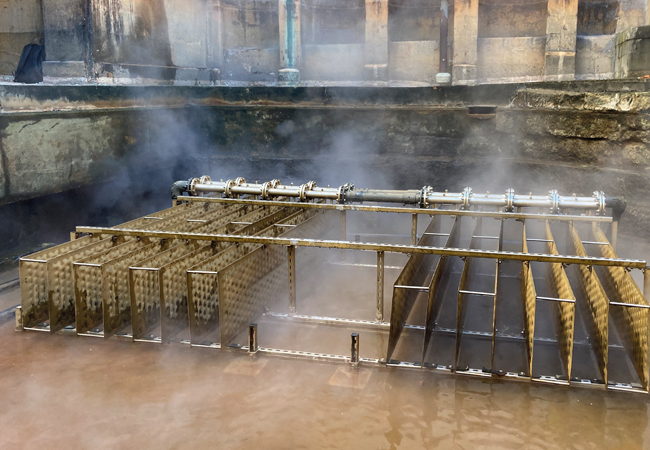
The heat exchangers are installed in the King’s Bath
In around 70AD, in what is now the city of Bath, a complex of Roman baths were constructed directly above a hot spring. Every day, this spring bubbles around 1.2 million litres of geothermal-heated water, at a temperature of 45oC, directly up through an opening in the floor of the King’s Bath, the largest pool in what remains of the Roman bathing and socialising complex. This hot water then flows from the bath complex, along a culvert system, known as the Great Drain, and into the River Avon.
Rather than let this hot water disappear, quite literally, down the drain, Bath and North East Somerset Council, which manages the visitor attraction, wanted to investigate the potential for using the geothermal heat to help it reduce its dependency on gas-fired heating for both the Roman Bathing Complex, which includes the Pump Room and the adjacent Roman Baths Clore Learning Centre.
In 2015, the council approached Buro Happold to undertake a feasibility study. The consulting engineer was already familiar with the challenge of extracting heat from the spring, having completed a similar scheme in 2021 for Bath Abbey.
The Abbey scheme used heat exchangers to extract heat from hot water flowing down the Great Drain, which it used to help heat the medieval building [see box: Using spring water to heat Bath Abbey]. ‘Although it would initially appear to be straightforward to use hot spring water as a heat source it is actually incredibly challenging,’ says Neil Francis, associate director at Buro Happold.
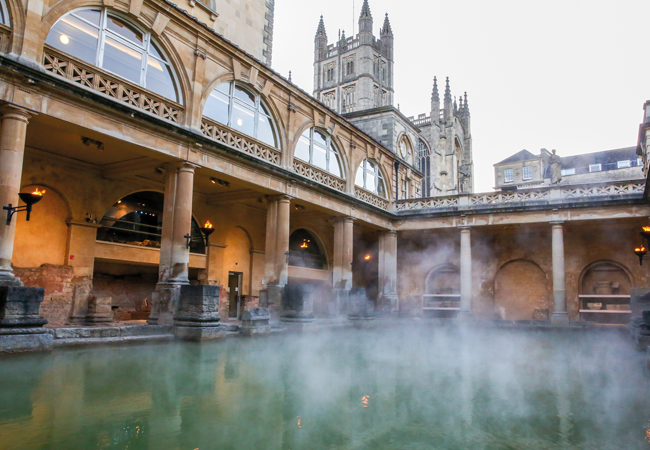
Buro Happold had to ensure the water was still steaming after the heat exchanger installation
As part of the feasibility study, the Buro Happold team looked at an earlier attempt to use this geothermal heat in the bath complex. ‘The Roman baths had experimented using the hot spring water in an open-loop system in the 1990s, but from our understanding this failed pretty much from the outset because the filters and pumps kept getting clogged with debris from the spring, even though they were designed to be used in the mining industry,’ recalls Francis.
Any new proposal would have to ensure that the water in the King’s Bath remained hot enough to continue to steam to retain its visual impact. ‘We did try to work out how much heat we could take out of the water before the bath would stop steaming but there are so many variables that it was almost impossible to come up with a definitive answer,’ Francis explains.
Buro Happold’s solution was to revert to the original open-loop heating system, which it knew had been sized to remove a very modest 100kW of heat and use this to meet the base heating load of the Roman Baths Complex and Clore Learning Centre. Records showed that on the few occasions the system had been run there had been no reported reduction in the quantity of vapour rising from the water’s surface. ‘We decided to base our proposal on the 100kW figure as a maximum for now as it had been proven not to have an impact. 100kW is also the limit for the project to benefit from the Renewable Heat Incentive,’ says Francis.
The Clore Learning Centre educates school children about Roman lives The Roman Baths Clore Learning Centre is a new education centre converted from a former nineteenth-century boiler house and a series of rooms above the former laundry that were built to service the Victorian spa buildings. These have now been turned into a series of teaching spaces, a World Heritage Site visitor centre complete with ancillary spaces including a cloakroom, WCs, offices and a lunchroom for the same client as the Roman Baths project, Bath and North East Somerset Council. Designed by architect Feilden Clegg Bradley Studios working with building services engineers Method Consulting, the £5m Clore Learning Centre provides a new entrance for school parties and improved access for those with disability. It is connected to the Roman Baths by a series of vaults spanning what was the original Roman street level, but which are now hidden below ground, beneath later developments. This vaulted undercroft is strewn with pieces of Roman-worked stone. These same vaults provide part of the pipe route that connects the new education centre to a heat exchanger that connects this heating system to the new blade heat exchangers and heat pump system in the Roman Baths. This supplies primary heat to the low-loss heating flow and return headers, which supply the building’s LTHW heating system at a temperature of 50°C flow/40°C return. System temperatures were based on Buro Happold’s original heat pump system (not the high temperature heat pump that was subsequently installed). Back-up heat is provided from two gas-fired boilers. The BMS monitors the temperature water delivered from the Roman Baths heat pump system, isolating the boilers. Heat is delivered to the teaching spaces through an underfloor heating system. This is supplemented by finned-tube heaters concealed behind joinery, including perimeter seating in the teaching spaces and cast iron radiators in some of the rooms. ‘Lower system flow temperatures resulted in larger heat emitters and pipework, which required detailed coordination with the design team to avoid clashes with the building structure and joinery’ says Dan Stretton, a Building Services and Environmental Associate at Method Consulting. Method worked closely with FCB Studios to ensure the teaching spaces has sufficient levels of daylight to minimise the use of electric light. Similarly, these spaces are naturally ventilated actuated openable windows and acoustic louvres.Some windows provide ventilation to upper floor spaces through a supply air plenum. Actuator-controlled louvres on the opposite side of the room regulate the rate of air flow based on CO2 level and temperature. In addition, the Victorian laundry-chimney is utilised to provide extract ventilation from some of the deep plan spaces. Because they are for teaching, ventilation of spaces was designed to comply with BB101. The project won a Civic Trust Award in 2023The Clore Learning Centre
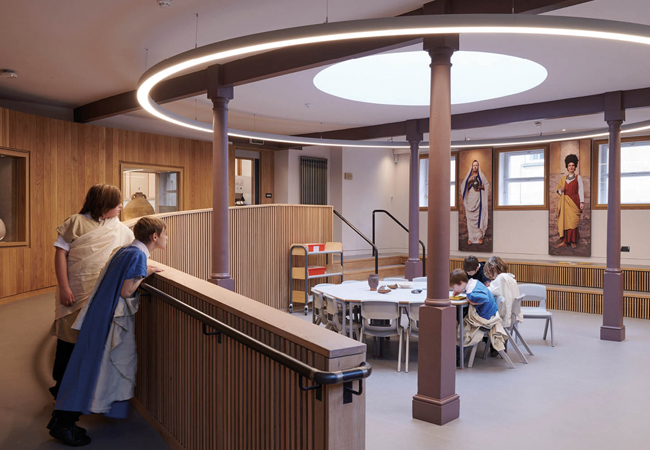
‘All being well, we have allowed space and sized new infrastructure for the system to be expanded to 150kW in the future, expanding from two 50kW heat pumps to three.’
Removal of 100kW of heat was calculated to cool the water in the King’s Bath from 44°C to 41°C. (We estimated the flow rate of the water in the Bath is 30m3 per hr (8.33 l·s-1) – a 3K acceptable temperature drop x 8.33 l·s-1 is 105kW). Another benefit of this solution was that the water’s 38°C exit temperature meant that it still retained enough residual heat when it flowed from the Roman Bathing Complex and down the Great Drain to ensure the Abbey’s heating system would continue to operate effectively. The temperature is 35°C when it gets to the Abbey heat exchangers.
Buro Happold knew from its Bath Abbey experience that one of the biggest challenges the team faced in using the spring water was the growth of algae and dealing with the corrosive nature of the thermal waters. The water contains various salts, iron oxide, and dissolved oxygen making it great for the human body to bathe in but corrosive to inferior metals. The sun on the water in the King’s Bath and the Great Bath encourages algae growth.
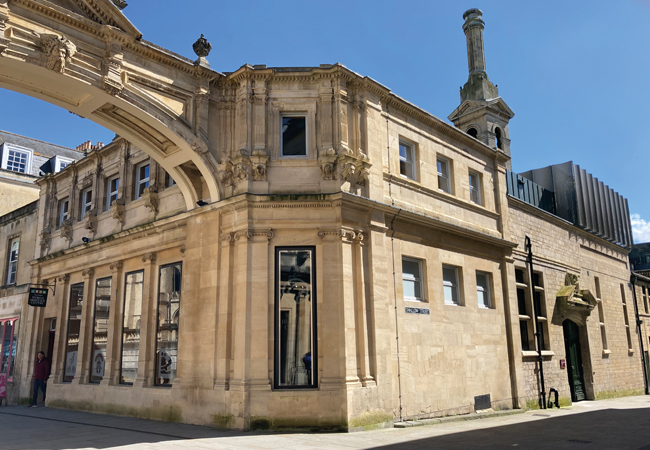
External view of the Clore Learning Centre
As a result, the Abbey’s design of the marine-grade stainless steel heat exchangers evolved so that all mechanical joints, crevices and other potential weak points were not in contact with the water.
For the Roman Baths, Buro Happold proposed a raft of 16 stainless steel energy blade heat exchangers – the same as the model now being used at Bath Abbey. These are concealed beneath the surface of the bath’s murky green waters. To eliminate the need for fixings, blade heat exchangers are supported on a stainless steel frame that is simply placed on the loose gravel bed floor of the bath and held in position by concrete blocks. Francis says: ‘If the FM team need to clean the heat exchangers, all they have to do is to drain the bath and pressure jet the assembly.’
Using spring water to heat Bath abbey
The Roman Great Drain runs adjacent to Bath Abbey, so when Buro Happold was asked to replace the building’s 100-year old heating system as part of the 2010 Heritage Lottery-funded Footprint Project, it set out to exploit the abbey’s unique location and use heat from the 1-1.2 million litres of water flowing from the Roman Baths Complex and other springs.
The floor of the Abbey was also being restored, so Buro Happold took advantage of the opportunity to install an underfloor heating system. This would be warmed by the heat reclaimed from the wastewater flowing through the Great Drain down to the River Avon.
Following numerous trials, a line of 10 pairs of stainless steel blade-heat exchangers were Installed in the invert of the 2.5m high Roman Drain – all 7m below current street level. At this point, and with the King’s Bath heat exchanger system in operation, the temperature of the culvert water was 35oC.
The heat exchangers are sized to extract 150-160kW of heat, lowering the water temperature in the culvert by 5K. The closed-loop solution supplies the heated water at 25oC to the Abbey’s conventional electric heat pumps, which then raise its temperature to 55oC for use in the abbey’s underfloor system.
Buro Happold’s Neil Francis described the challenges Buro Happold encountered with this project in an article he wrote in 2019, before the project was completed (‘A spring in their step’, February 2019, CIBSE Journal bit.ly/CJMay23BA).
Draining down the Baths is something that happens about four times a year anyway to wash naturally occurring silt and algae build-up down the drain. It is interesting to see the Great Bath’s lead sheet lining, the equivalent of a modern tiled swimming pool. In Georgian times, at the height of social bathing, the baths were drained down much more frequently. The heat exchangers form part of a closed-loop system with water as the heat transfer medium. ‘Using a closed loop means that even if the heat exchangers get completely covered in debris, water will still circulate through them, so the worst that could happen is that the system efficiency would drop over time.
In a very worst case, the heat pumps would trip-out and raise an alarm,’ explains Francis. The council decided to go with the proposal. As the Roman Baths is an ancient monument, the position of the heat exchangers and routes of all pipework were subject to Scheduled Monument Consent. To prevent damage to the bath, high-density polyethylene pipes have been placed on the floor of the bath to link the heat exchanger array to new 316L stainless steel internal pipework. This, in turn, connects to two new high-temperature water-to-water heat pumps. These raise the water temperature from 32°C to 75°C, after which the high temperature water is collected in a buffer tank.
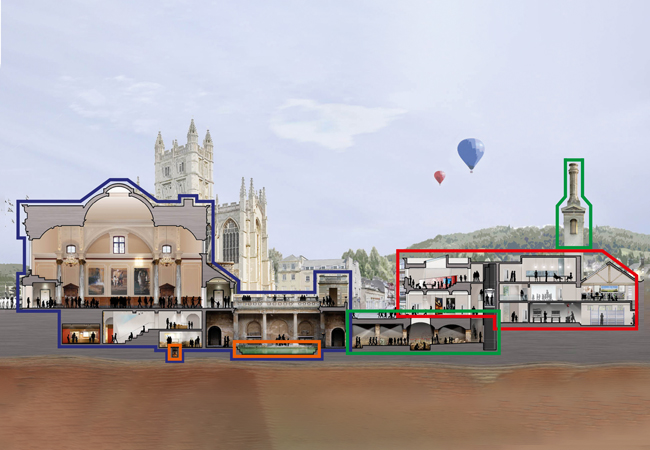
Where heat is reused from King’s Bath
■ Red: Clore Learning Centre with newer lower temperature heating.
■ Green: other areas associated with Clore Learning Centre but no heating.
■ Blue: main Roman Baths Complex with older, higher-temperature heating.
■ Orange: Great Drain (left square) and level of King’s Bath containing the heat exchangers.
Francis says it was fortunate that the project took so long to get from feasibility to installation because it meant that heat pump technology had moved on significantly. Originally, the intention was to use conventional heat pumps, similar to those used for the Bath Abbey scheme. These would have raised the water temp from 20°C to 25°C off the heat exchangers up to a maximum of 55oC. Interestingly, 25oC was actually the maximum acceptable source temperature on these original heat pumps and the basis for sizing the heat exchangers.
However, by the time the scheme went to tender, high-temperature heat pump technology was becoming mainstream. The high-temperature Mitsubishi ClimaVenita pumps raise the system water temperature to 75°C, which enables the heated water to make a significant contribution to heating both the Roman Bathing Complex, which has a high-temperature heating system based on Victorian cast- iron radiators, and the Clore Learning Centre, which has a newer, lower temperature heating system. The original design 25°C to 55°C conventional heat pumps had a COP of about 4.0-4.5, whereas the 25°C-32°C to 75C high temp heat pumps have a COP of about 3.0-3.5.
The lower COP was deemed acceptable on the basis that it would allow far greater use of the heat generated, particularly in preheating the return water to the Roman Baths’ gas-fired boilers.
‘In time, the plan is to fine-tune the controls and introduce a seasonal set-point adjustment to improve the COP,’ says Francis. Raising the temperature of the heat exchangers from 25°C to 32-35°C meant roughly doubling the size of the heat exchanger array, beause of the ‘log mean temperature difference’ sizing method. ‘It’s very important to take this into account,’ says Francis.
Water is circulated from the heat pump buffer tank through a second set of heat exchangers. These have been inserted to hydraulically separate the new system from the two existing heating systems it has been designed to serve.
The largest heat exchanger serves the Victorian cast-iron radiator system that heats the Roman Bathing Complex. This supplies heat at 75°C to the heating return pipework to preheat the water before it enters the system’s gas-fired boiler. A smaller heat exchanger serves the Clore Learning Centre; this supplies heat to the building’s newer heating system at 55°C.
Francis says it was a major challenge finding somewhere to fit the new heat pumps and their associated buffer tank, heat exchangers and circulating pumps in addition to establishing a route for the new pipework through the building’s warren of subterranean vaults and passages.
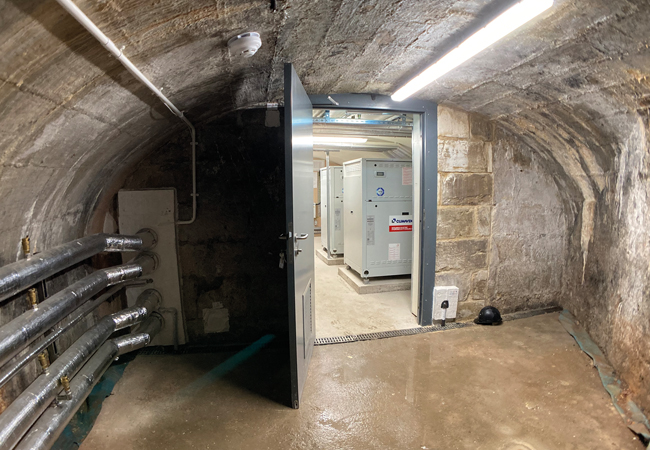
The heat pumps are installed in a vault under a road
The only space available for the new heat pumps was a damp vault, beneath the main road adjacent to the complex. To make the space usable, this has had to be tanked and a radon membrane fitted to create a suitable space for the new plant. A new power supply was necessary as the Roman Baths was already at its maximum demand. ‘The number of people we had to talk to and the permissions that had to be obtained took a huge amount of effort,’ he recalls. ‘Surveys, investigations, mockups, consultations, approvals, logistics, enabling works packages – these were all far more time-consuming than the technical design itself and needed a great deal of patience.’
The system is currently being snagged prior to handover. The 100kW it will contribute represents about a third of total peak heating load of both venues, although it will actually contribute up to two-thirds of the annual energy usage. ‘It’s a really nice system. It has been running since before Christmas, putting heat into the Roman Bathing Complex buildings at 75°C and into the Clore Learning Centre at 55°C,’ says a delighted Francis.
A further benefit is that, in addition to providing the local authority with carbon savings to help it meet its target of net zero carbon across its estate by 2030, it will also showcase to thousands of visitors how innovative technology can enable the ancient Roman Bathing Complex to contribute towards a net zero carbon future.
